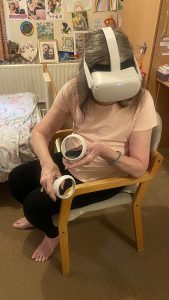Lee, EJ., Park, SJ. (2020) ‘Immersive Experience Model of the Elderly Welfare Centers Supporting Successful Aging’. Front. Psychol. 11:8. doi: 10.3389/fpsyg.2020.00008
https://www.frontiersin.org/articles/10.3389/fpsyg.2020.00008/full
Angelini, L., Caon, M., Couture, N., Khaled, O. A., and Mugellini, E. (2015). “The multisensory interactive window: immersive experiences for the elderly,” in : Adjunct Proceedings of the 2015 ACM International Joint Conference on Pervasive and Ubiquitous Computing and Proceedings of the 2015 ACM International Symposium on Wearable Computers (New York, NY: ACM), 963–968.
Baltes, P. B., and Baltes, M. M. (1990). “Psychological perspectives on successful aging: the model of selective optimization with compensation,”in Successful aging: Perspectives from the behavioral sciences, eds P. B. Balte and M. M. Baltes (Cambridge: Cambridge University Press), 1–34. doi: 10.1017/cbo9780511665684.003
Calogiuri, G., Litleskare, S., Fagerheim, K. A., Rydgren, T. L., Brambilla, E., and Thurston, M. (2018). Experiencing nature through immersive virtual environments: environmental perceptions, physical engagement, and affective responses during a simulated nature walk. Front. Psychol. 8:2321. doi: 10.3389/fpsyg.2017.02321
Chodzko-Zajko, W., Schwingel, A., and Park, C. H. (2009). Successful aging: the role of physical activity. Am. J. Lifestyle Med. 3, 20–28. doi: 10.1177/1559827608325456
Cummings, J. J., and Bailenson, J. N. (2016). How immersive is enough? A meta-analysis of the effect of immersive technology on user presence. Media Psychol. 19, 272–309. doi: 10.1080/15213269.2015.1015740
Gallistl, V. (2018). The emergence of the creative ager–On subject cultures of late-life creativity. J. Aging Stud. 46, 93–99. doi: 10.1016/j.jaging.2018.07.002
Havighurst, R. J. (1963). Successful aging. Proc. Aging: Soc. Psychol. Perspect. 1, 299–320.
Hayflick, L. (2000). The future of ageing. Nature. 408:267. doi: 10.1038/35041709
Hong, D. H., and Yoo, J. W. (2017). A study on the characteristics of seniors welfare center as a leisure activity space for the elderly -concentrated on seniors welfare center of Changwon city. JAIK PD. 19, 61–72. doi: 10.6564/JKMRS.2015.19.2.061
Duay, D. L., and Bryan, V. C. (2006). Senior adults’ perceptions of successful aging. Educ. Gerontol. 32, 423–445. doi: 10.1080/03601270600685636
Rowe, J. W., and Kahn, R. L. (1998). Successful aging: The MacArthur Foundation Study. New York, NY: Pantheon.
Rowe, J. W., and Kahn, R. L. (2015). Successful aging 2.0: conceptual expansions for the 21st century. J. Gerontol. B. 70, 593–596. doi: 10.1093/geronb/gbv025
Whitlock, L. A., McLaughlin, A. C., and Allaire, J. C. (2012). Individual differences in response to cognitive training: Using a multi-modal, attentionally demanding game-based intervention for older adults. Comput. Hum. Behav. 28, 1091–1096. doi: 10.1016/j.chb.2012.01.012

